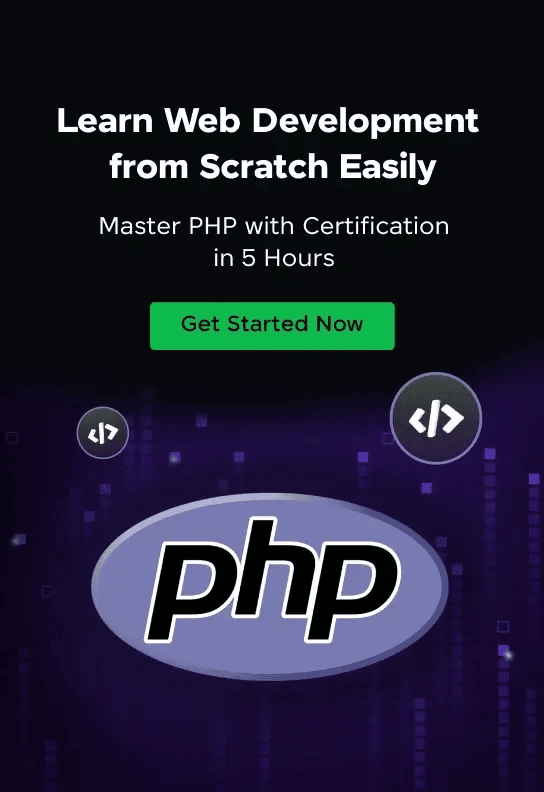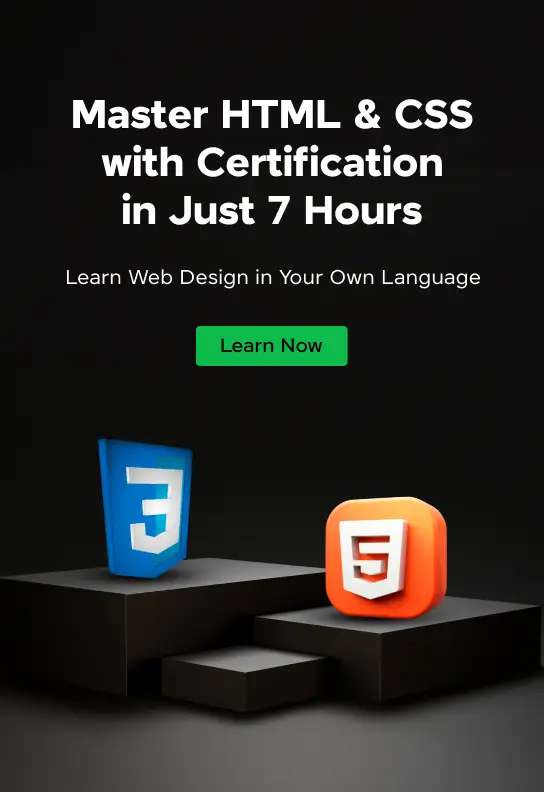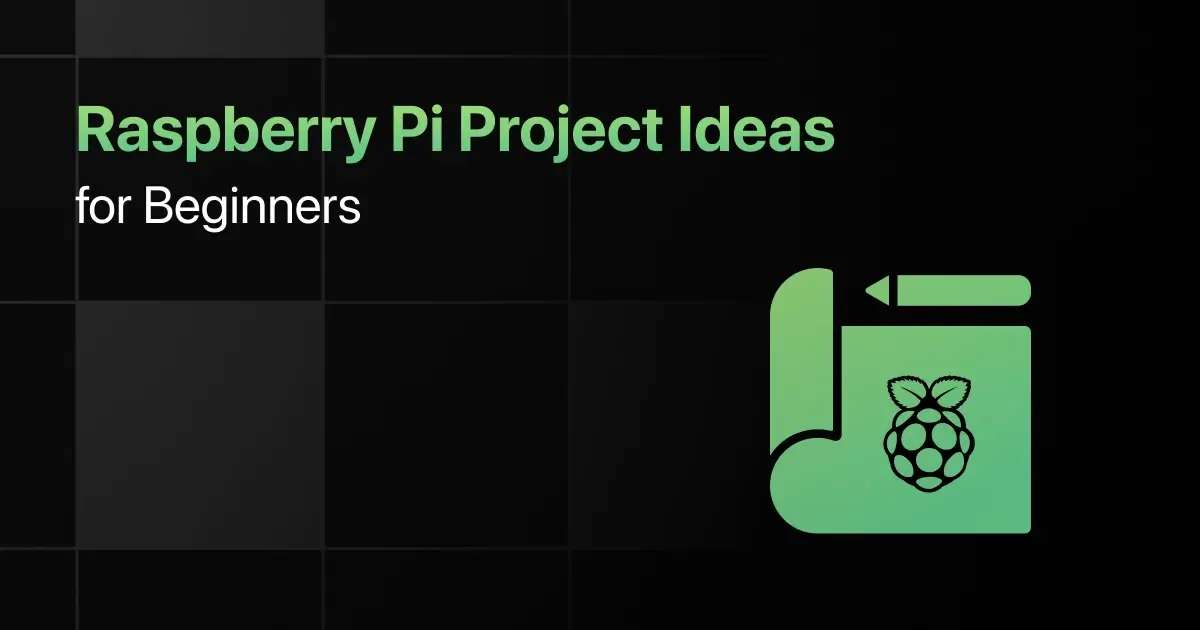Best Websites to Learn PHP
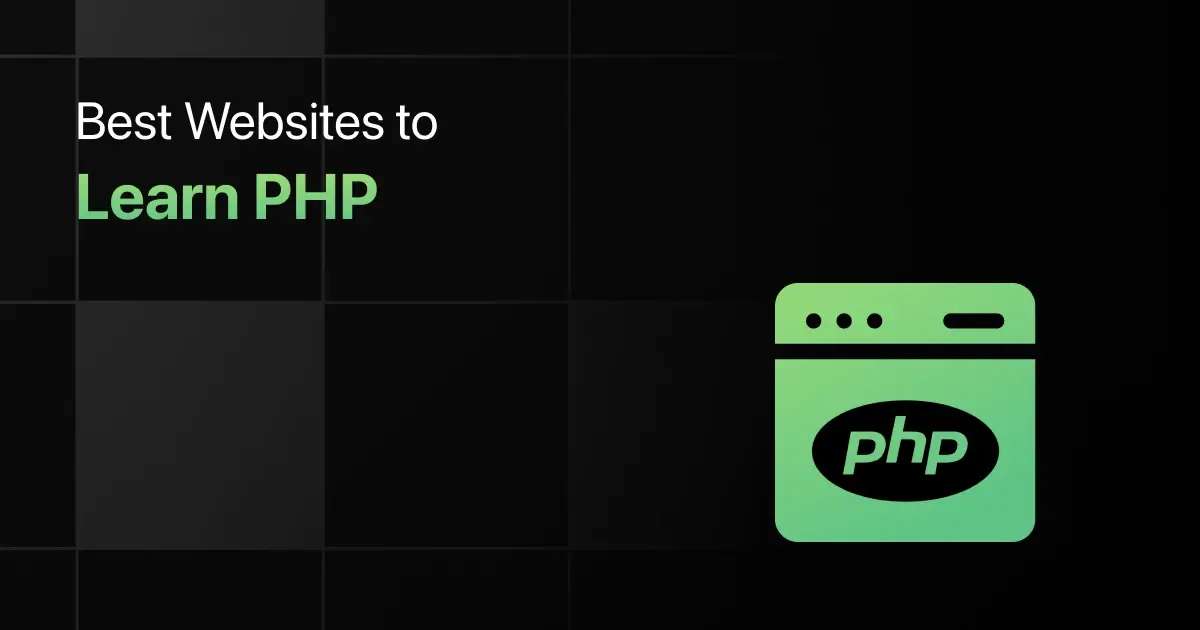
Thinking about building dynamic websites and looking for a way to learn PHP without spending a rupee?
Explore the best websites to learn PHP for free, where you can start your journey into server-side scripting and web development without any cost.
10 Best Websites for PHP – Overview
Here’s an overview of the top 10 websites to learn PHP Programming:
| S.No. | Website Name | Course Duration | Pricing | Certification | Website Link |
|---|---|---|---|---|---|
| 1 | GUVI | 5 hours | Paid | Yes | Visit Now |
| 2 | Coursera | 30 hours | Freemium | Yes | Visit Now |
| 3 | PHP Manual | Self-paced | Free | No | Visit Now |
| 4 | W3Schools | Self-paced | Free | No | Visit Now |
| 5 | Codecademy | 17 hours | Freemium | Yes | Visit Now |
| 6 | FreeCodeCamp | 4-5 hours | Free | No | Visit Now |
| 7 | Udemy | 37 hours | Paid | Yes | Visit Now |
| 8 | TutorialsPoint | Self-paced | Free | No | Visit Now |
| 9 | PHP: The Right Way | Self-paced | Free | No | Visit Now |
| 10 | Pluralsight | 5.2 hours | Paid | Yes | Visit Now |
Best Websites to Learn PHP for Beginners
Below is the list of best websites to learn PHP for beginners:
1. GUVI
GUVI’s PHP course is designed to master server-side programming with PHP. This course, taught by industry experts, provides a comprehensive understanding of PHP programming for building dynamic web pages.
It includes beginner to expert modules, covering PHP, JSON, GET, POST, PHP libraries and functions, file and directory manipulation, and working with different PHP environments.
Course Diversity: This PHP course includes beginner, intermediate, advanced, and expert modules, focusing on various aspects of PHP programming.
Topics include JSON, GET, POST, PHP environments like XAMPP and Geany, and file and directory manipulation.
Pricing: INR 1499
Certifications: Globally recognized certificate from GUVI, an IIT-M incubated company.
Language Options: English, Hindi, and Tamil.
Course Duration: 5 hours of recorded content.
2. Coursera
“Building Web Applications in PHP” by the University of Michigan on Coursera is a course designed for learners to explore the basic structure of a web application and understand how a web browser interacts with a web server.
It also provides an introduction to HTML and CSS and teaches how to install and use an integrated PHP/MySQL environment like XAMPP or MAMP.
Course Diversity: The course includes modules on HyperText Markup Language (HTML), Cascading Style Sheets (CSS), PHP basics, arrays, functions, and handling HTML forms.
It also covers basic syntax and data structures of PHP, variables, logic, iteration, arrays, error handling, and superglobal variables.
Pricing: Free with an option for a paid certificate.
Certifications: Shareable certificate
Language Options: English, with some content available in 22 different languages.
Course Duration: 30 hours
3. PHP Manual
The PHP Manual on the official PHP website is a comprehensive resource for learning and referencing PHP programming language. This manual is extensive and covers every aspect of PHP, from basic syntax to advanced features.
It includes detailed information on PHP installation, configuration, language reference (including types, variables, constants, operators), security best practices, various PHP features, function reference for different PHP extensions, and much more.
Course Diversity: The manual offers a wide range of topics such as basic PHP syntax, control structures, functions, classes and objects, error handling, and security guidelines.
It also delves into specific PHP functionalities like HTTP authentication, cookies, sessions, file uploads, and database connections.
Pricing: Free
Certifications: Nil
Language Options: English, with certain content translated into other languages.
Course Duration: Self-paced
4. W3Schools
W3Schools’ PHP Tutorial is designed to provide a comprehensive introduction to PHP, a popular server-side scripting language used for developing dynamic web pages.
The tutorial covers PHP’s basic structure, syntax, and data structures, offering an easy-to-understand approach suitable for beginners. It includes hands-on examples, exercises, and an interactive “PHP Tryit” editor for practical learning.
Course Diversity: The tutorial encompasses a range of PHP programming concepts, such as variables, logic, iteration, arrays, error handling, and superglobal variables.
It also provides an introduction to HTML and CSS, essential for web development.
Pricing: Free
Certifications: Certification for an extra fee
Language Options: English
Course Duration: Self-paced
5. Codecademy
The PHP Skill Path on Codecademy is a comprehensive program that introduces learners to the fundamentals of PHP, one of the most widely used languages in web development.
This path includes lessons on PHP basics, using PHP with HTML forms, and creating classes and objects. It offers a hands-on approach to learning with real projects and quizzes.
Course Diversity: The skill path is broken down into various units and lessons, such as PHP Variables, Strings, and Numbers; Functions; Conditionals and Logic; Arrays and Loops; PHP and HTML; and Classes and Objects.
Pricing: Free, but complete access and a certificate of completion are included with Codecademy’s paid plans.
Certifications: Certificate of completion with paid plans.
Language Options: English
Course Duration: 17 hours
6. freeCodeCamp
freeCodeCamp’s PHP Programming Language Tutorial, available through Class Central, provides an introduction to PHP, covering the installation of Windows, choosing a text editor, writing HTML, and fundamental PHP programming techniques.
Course Diversity: The course includes topics such as working with strings, numbers, variables, user input, building basic calculators, mad libs game, using checkboxes, associative arrays, classes, and objects.
7. Udemy
This course on Udemy, created by Edwin Diaz and Coding Faculty Solutions, is designed for complete beginners in PHP. It covers everything needed to become a professional PHP developer, including practical exercises and projects.
The course focuses on creating a Content Management System (CMS) like WordPress, Drupal, or Joomla, using databases, MySQL, object-oriented programming, and PHP security.
Course Diversity: Topics include working with databases, object-oriented programming, launching applications online, handling HTML form submissions, AJAX, password hashing, email sending, using composer, clean URL creation, bootstrap utilization, and much more.
Pricing: ₹3,499 or ₹850/month
Certifications: Certificate of completion
Language Options: The course is available in English, with subtitles in English and Arabic, among other languages.
Course Duration: 37 hours
8. TutorialsPoint
TutorialsPoint offers a detailed PHP tutorial that serves as a comprehensive guide for learners interested in PHP programming.
The tutorial covers an array of topics including basic syntax, environment setup, data types, variables, operators, control structures, functions, and more.
It’s aimed at providing a solid foundation in PHP for website development, emphasizing practical implementation and coding examples.
Course Diversity: The tutorial addresses a wide spectrum of PHP aspects, including fundamental programming concepts, file handling, object-oriented programming, and web development specifics.
It systematically progresses from basic to advanced topics, making it suitable for both beginners and intermediate learners.
Pricing: Free
Certifications: Nil
Language Options: English
Course Duration: Self-paced
9. PHP: The Right Way
“PHP: The Right Way” is an easy-to-read, quick reference guide for PHP best practices and accepted coding standards. It offers links to authoritative PHP tutorials around the web, aiming to guide PHP developers in adopting current best practices and secure coding standards.
The website covers a comprehensive range of topics including setup and installation, code style guide, language highlights, databases, errors and exceptions, security, testing, and deployment.
Course Diversity: The site addresses multiple aspects of PHP development, including language basics, programming paradigms, namespaces, the Standard PHP Library, command line interface, dependency management, database interaction, error handling, security considerations, testing, and server deployment.
Pricing: Free
Certifications: Nil
Language Options: English, Deutsch, Español, Français, Bahasa Indonesia, Italiano, Japanese, Korean
Course Duration: Self-paced
10. Pluralsight
The “PHP Fundamentals” course on Pluralsight, instructed by Jill Gundersen, is designed to teach the foundations of PHP programming on the LAMP stack (Linux, Apache, MySQL, and PHP).
This course targets beginners and aims to provide a thorough understanding of PHP’s syntax and its application in web development, emphasizing form processing, database integration, and object-oriented programming.
Course Diversity: The course includes various modules, such as general types, functions, strings, arrays, classes and objects, operators and control structures, databases, and web programming, offering a well-rounded curriculum for PHP learning.
Pricing: Subscription service, starting at $29 per month after a 10-day trial.
Certifications: Certificate of completion
Language Options: English.
Course Duration: 5 hours and 8 minutes
Frequently Asked Questions
1. What are the best websites for learning PHP?
The best websites for learning PHP are:
- GUVI
- Coursera
- PHP Manual
- W3Schools
- Codecademy
- freeCodeCamp
- Udemy
2. What are some free PHP learning websites along with certifications?
GUVI, Coursera, PHP Manual, W3Schools, and freeCodeCamp are some free PHP learning websites along with certifications.
3. Why should I choose website for learning PHP?
You should choose a website for learning PHP because they offer flexibility and have a variety of learning resources. They cater to different learning styles with interactive tutorials, video lectures, and hands-on exercises.
4. How do I choose the right website for learning PHP?
You can choose the right website for learning PHP by considering factors like course content quality, learning style compatibility (videos, interactive exercises), instructor expertise, community support, and pricing.
5. Can a beginner learn PHP effectively through websites?
Yes, beginners can effectively learn PHP through websites. Many platforms offer beginner-friendly courses that start with basics and gradually progress to more complex topics.
6. Are there websites that offer content in multiple languages for learning PHP?
Yes, some websites like Coursera, PHP: The Right Way, and Udemy provide PHP learning content in multiple languages and subtitles.
Final Words
These websites are like your personal web development tutors, offering a range of PHP tutorials and exercises for all skill levels.
Keep checking this article as we will keep updating this space as more websites make space in the heart and study schedule of students preparing for placements and competitive exams.
Explore More PHP Resources
Explore More Websites
- Python
- Java
- Coding
- C++
- C Programming
- SQL
- JavaScript
- Data Science
- HTML & CSS
- Web Development
- Data Structures and Algorithms
- AI & Machine Learning
- Ethical Hacking
- Android Development
- React JS
- Game Development
- Competitive Programming
- Digital Marketing
- Tableau
- DBMS
- R Programming
- Cyber Security
- Excel
- Node JS
- Data Analytics
- Bootstrap
- Cloud Computing
- Operating System
- Angular
- RPA
Related Posts
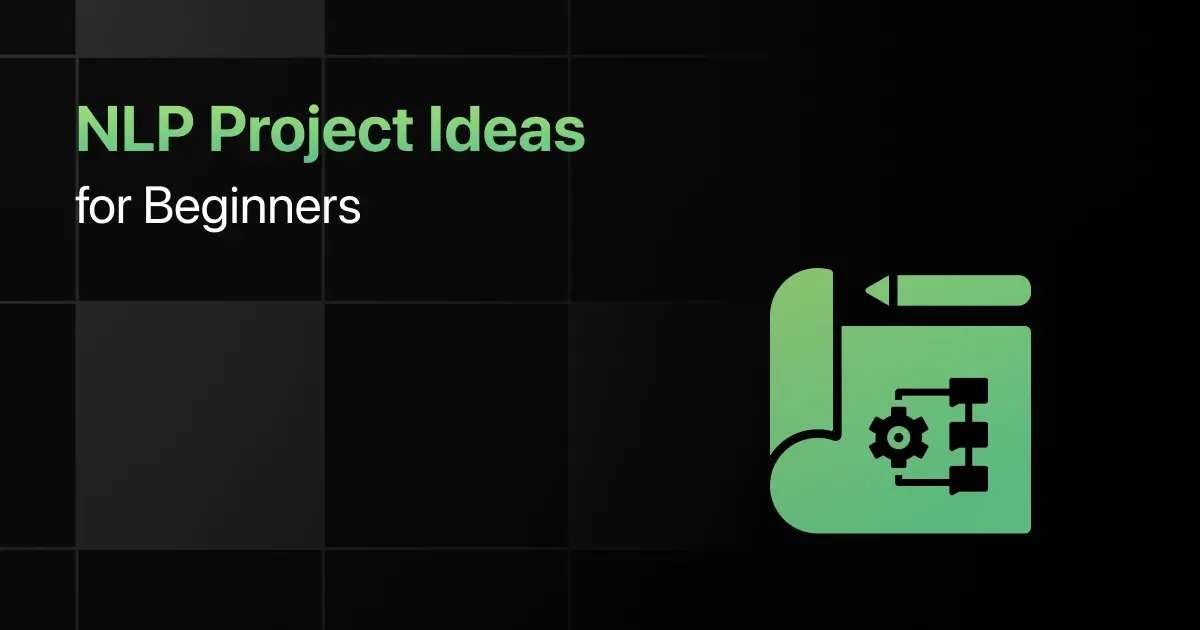


Golang Interview Questions
Are you preparing for your first Golang interview and wondering what questions you might face? Understanding the key Golang interview questions …
Warning: Undefined variable $post_id in /var/www/wordpress/wp-content/themes/placementpreparation/template-parts/popup-zenlite.php on line 1050

